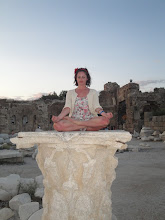Reading about, studying and practicing the Pranayama exercises in B.K.S Iyengar’s Light on Yoga has increased my interest and practice of this limb of yoga. I particularly liked the advice and the way Iyengar laid out these exercises in a clear, practical and accessible way. Rather than seeming like something mystical, unachievable and intimidating Iyengar has carefully described pranayama exercises and explained the benefits in a logical way.
Studying the chapter on pranayama has helped me to integrate 15 - 30 minutes of pranayama into my self practice on a regular basis and Nadi Sodhana Pranayama nearly daily. I have already felt the benefits of cleansing the lungs and building lung capacity and have been able to increase the number of repetitions and length of retentions.
I have always found that engaging ujaji breath and focusing on the breath during asana practice is vital to maintaining focus, building internal heat and providing energy and stamina to flow through the practice and open the body into difficult postures. Using ujaji breath is what helped to transform my yoga experience from a purely physical one to become a meditative and spiritual one. Reading more into pranayama helped me to understand why the breath is so integral to yoga; breath is the ‘life force’ and is connected directly to the mind, so naturally controlling and focusing on it will have a powerful affect.
In our daily life we are not normally aware of our breath or acknowledge it despite it being the crucial force which keeps us alive. Therefore concentrating on the breath is calming, humbling and grounds us in the moment - we are focusing only on the actions which are necessary to our being. Iyengar explains "Evenness of breathing leads to healthy nerves and so to evenness of mind and temper" (p363, Light on Yoga).
I think that pranayama practice is more important than ever because we are living in a modern, technology focused, busy and often hectic society where people are constantly taking in information from different sources and thinking about numerous things at once. In this environment it is easy to loose touch of the simplicity of just ‘being in the moment, just breathing’. By taking away all the other distractions and stimulants and focusing purely on the breath during exercises such as kapalabhati or nadi shodhana it brings attention to being alive, being in the present and reconnects us with our life force.
The Hatha Yoga Pradipika also helped deepen my understanding of pranayama and why it helps to calm and bring clarity to the mind because, "the breathing process is directly connected to the brain and central nervous system [...] By becoming aware of the nature of the breath and by retraining it the whole system becomes controlled. When you retain the breath you are stopping nervous impulses in different parts of the body and harmonising the brain wave patterns." (p150-1, Hatha Yoga Pradipika)
Before starting the teacher training course I was aware of and engaged the bandhas in my practice. However I didn’t understand the true reason we applied bandhas and thought they just helped with core strength. I found Iyengar's descriptions of engaging the bandhas in pranayama, how this works and why it is necessary to lock the pranic energy in the body straightforward and helpful. Likening the process to an electrical current which needs transformers, conductors and fuses etc as otherwise it is lethal highlighted the importance of employing the bandhas correctly and helped me focus on this in my practice:
“When electricity is generated, it is necessary to have transformers, conductors, fuses, switches and insulated wires to carry the power to its destination, as without these the electricity generated would be lethal. When prana is made to flow in the yogi’s body by the practice of pranayama it is equally necessary for him to employ bandhas to prevent the dissipation of energy and to carry it to the right quarters without causing damage elsewhere. Without the bandhas, prana is lethal” (p365 Light on Yoga).
I have read a number of different descriptions of the chakra system and kundalini awakening and I found Iyengar's very clear and concise. I found Iyengar’s simple explanation of the ultimate goal for pranayama practice helpful, "With mastery of the three bandhas, the yogi is at the cross-roads of his destiny" and the path we aim to follow "leads to Yoga or union with the Supreme Soul" and "He will then acquire moral and spiritual power. The power within him will shine forth like the sun." (p367 Light on Yoga). Following reading Iyengar’s description I found it easier to digest this idea when echoed in the Hatha Yoga Pradikipa as follows, "Prana is the tangible manifestation of the higher Self. Hatha yoga uses prana as the key to expand the awareness of consciousness and realise the Self." (p157 Hatha Yoga Pradikipa).
I find pranayama, specifically kumbhaka, a powerful way of clearing the mind and coming to a moment of complete stillness, purity and bliss. During kumbkaka I can feel the energy flowing freely through the body and gain a sense of inner strength and contentment. Pranayama brings about a meditative state as Iyengar explains, "in the practice of pranayama the sense are drawn inwards and in the silence of kumbhaka the aspirant hears his inner voice calling: 'Look within! The source of happiness is within!'" (p365 Light on Yoga).
In summary I have found reading Iyengar's chapter on pranayama highly beneficial to integrating pranayama exercises into my self practice. It has provided a clear explanation which supports and builds on my own experience of the breath being calming and bringing one pointed focus to my yoga practice. Iyengar’s teachings have enriched my asana and pranayama practice as I play with the bandhas and breath with a sense of locking in the pranic energy. This root knowledge has enabled me to gain a deeper understanding of the pranic and chakra systems and kundalini awakening.

No comments:
Post a Comment